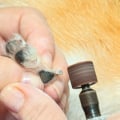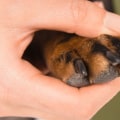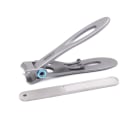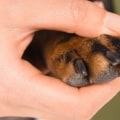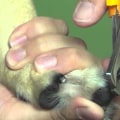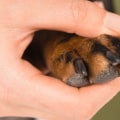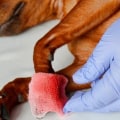Teresa Manucy's tips on how to cut your dog's nails safely and painlessly. Dogs need to have their nails cut every 2 to 4 weeks, depending on their growth rate, to prevent their nails from growing too much. Spending time to desensitize your dog to nail clippers, rewarding him for his calm behavior, makes him feel comfortable. Most dogs with their nails trimmed as puppies can handle the process properly as adults.
Claw and nail disorders Average cost Parasitic effects on a claw can be resolved by eliminating the parasite and then repairing the nail. The bacterial infection will be eradicated with antibiotics; treatment with the drug may last several months. A toenail damaged by trauma may require treatment with daily antiseptic baths, along with the removal of the broken or cracked claw. A dog with an immunosuppressive disorder will need a prescription for oral prednisone.
Usually, the dosage is gradually reduced as the nail heals. Topical creams, omega 3 supplements and vitamin A and E, and other treatments may be recommended. The good news is that you can shorten your dog's rapids slowly, steadily and over time. To do this, professional hairdressers recommend the alternative cut line (ACL), which is a 90-degree cut, in addition to the standard 45-degree cut.
The purpose of the 90-degree cut is to remove the extra cover from the nail, which helps to quickly believe that it needs to be removed to protect itself. The presence of the fast, rich in blood vessels and nerves, is proof that dogs' nails are not hollow. As a loving and responsible dog owner, it's essential to understand several aspects of your pet's health, including the structure and function of their nails. A study of 35 dogs found that cutting their nails is a stressful experience for dogs, but it gets better over time.
Let them see and smell all the tools, and let them acclimate to the sound of the dog nail grinder if you're using one of those. Sometimes dogs can get their long nails caught on carpets or on grass roots, causing them to literally come off if they're brittle. So if you've ever wondered why dogs hate having their nails cut, it's not because they feel pain. Scissor or plier clippers can be used for both small and large dogs, but you might find it easier to use a nail clipper made specifically for cats or small dogs if you have a miniature dog.
There are several types of nail clippers for dogs, including scissors, grinder tools designed specifically for dogs, and types of guillotine. A dog with claws has all of its nails removed, which seems unnecessary, but some owners don't want to take care of the nails at all. If your dog is particularly nervous, try to cut one or two nails per session and gradually increase the number as he gets more comfortable. Trimming or filing your dog's nails regularly should be a routine part of dog grooming, but for many dogs, trimming their nails can be extremely stressful.
In dogs with light-colored nails, the fast appears as a pink area, while it is more difficult to see in dogs with dark toenails. File your dog's nails is primarily done to remove any sharp tips or fragments that remain after you cut your dog's nails. Not to be confused with a motorized dog nail grinder, a dog nail file is simply a manual nail file for dogs. The misconception that dogs' nails are hollow may be due to the fact that some dogs have a central cavity in the middle layer, which is more pronounced in certain breeds or individual dogs.
